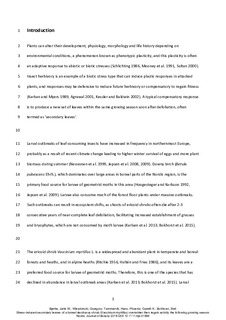Stress-induced secondary leaves of a boreal deciduous shrub (Vaccinium myrtillus) overwinter then regain activity the following growing season
Journal article, Peer reviewed
Accepted version

Åpne
Permanent lenke
http://hdl.handle.net/11250/2561137Utgivelsesdato
2018Metadata
Vis full innførselSamlinger
- Publikasjoner fra CRIStin - NINA [2364]
- Scientific publications [1392]
Originalversjon
10.1111/njb.01894Sammendrag
The ericoid shrub Vaccinium myrtillus is one of several deciduous boreal plants that respond to larval defoliation by compensatory production of a new set of leaves within the same growing season soon after defoliation. This new set is termed as ‘secondary leaves’. The physiological performance and longevity of secondary leaves is poorly understood. Following a multi-year larval outbreak in boreal Norway, we therefore monitored the fate of the secondary leaves from 2014 to 2016. We observed that secondary leaves were still green upon onset of snow season and that the same leaves were still attached and green when snow melted in spring. During the early growing season of 2015, the overwintering leaves were consumed by moth larvae, but the secondary leaves produced in mid-July 2015 overwintered and were not consumed by larvae the next growing season. Our monitoring shows that most of these leaves remained attached until late August, while the contents of chlorophyll and nitrogen remained high until July. The flavonoid (anthocyanin) content of overwintering leaves increased shortly after snowmelt, and this coincided with a short-lasting colour change from green to violet-bronze. This was probably a protective response to the abrupt increase in solar radiation. Overall, secondary, overwintering leaves were free of snow and physiologically active for ca. 6.5 months, which is 2-3 months more than the longevity of primary leaves in the study area. We conclude that wintergreen leaves probably rendered an important carbon sequestration contribution in the critical first phase of the growing season until new side branches with new leaves were developed. Hence, the novel results reported here on the facultative wintergreen growth habit of V. myrtillus appears to be a successful strategy.